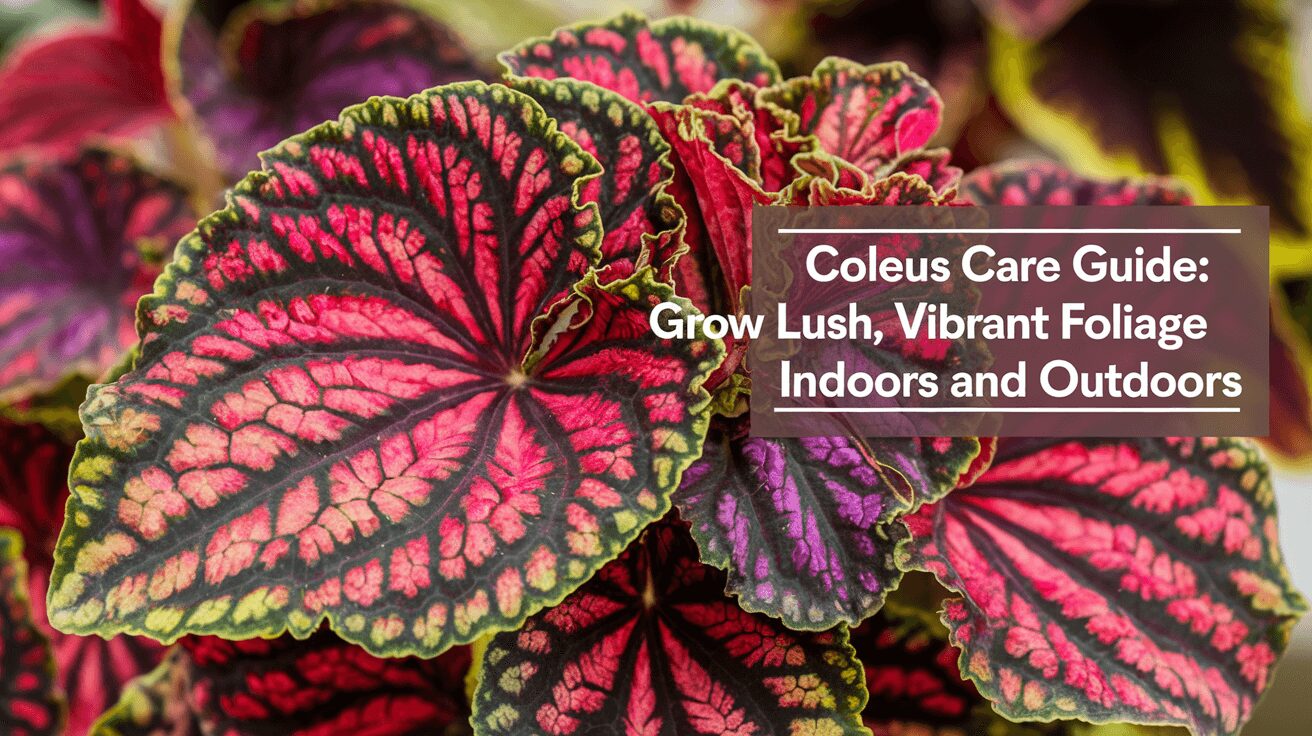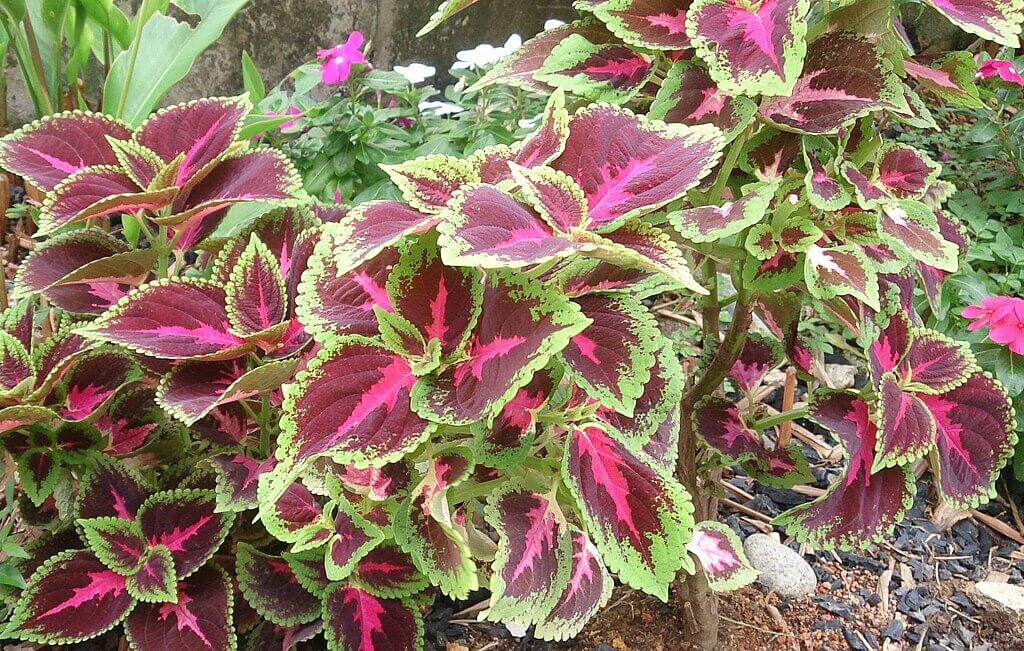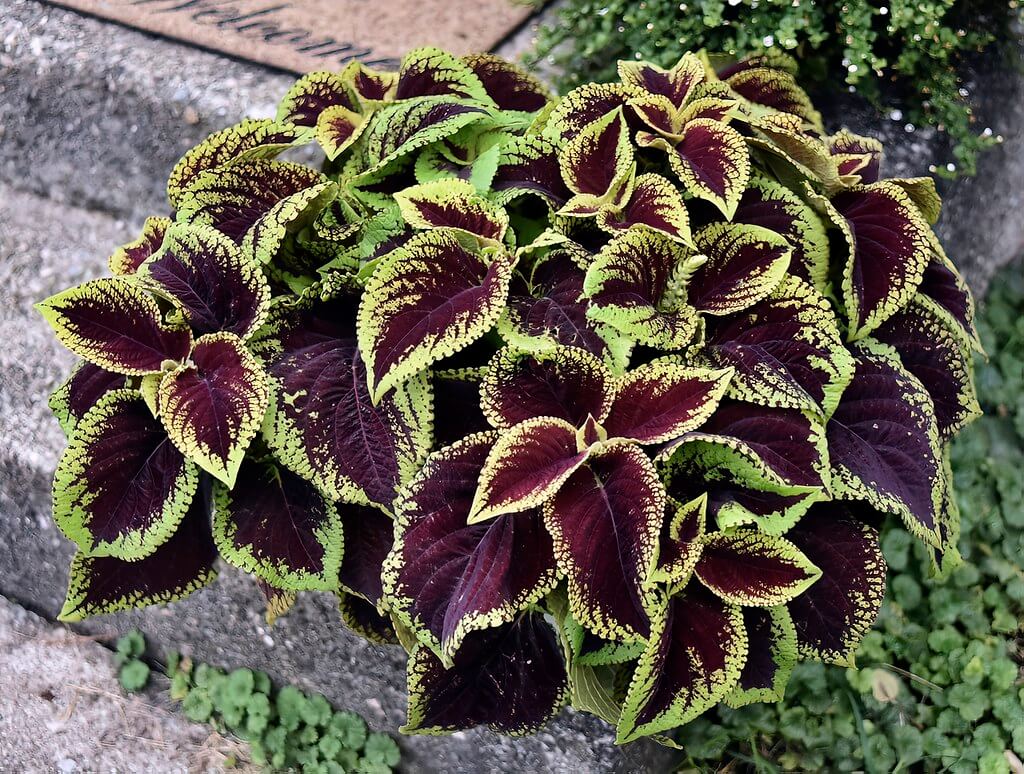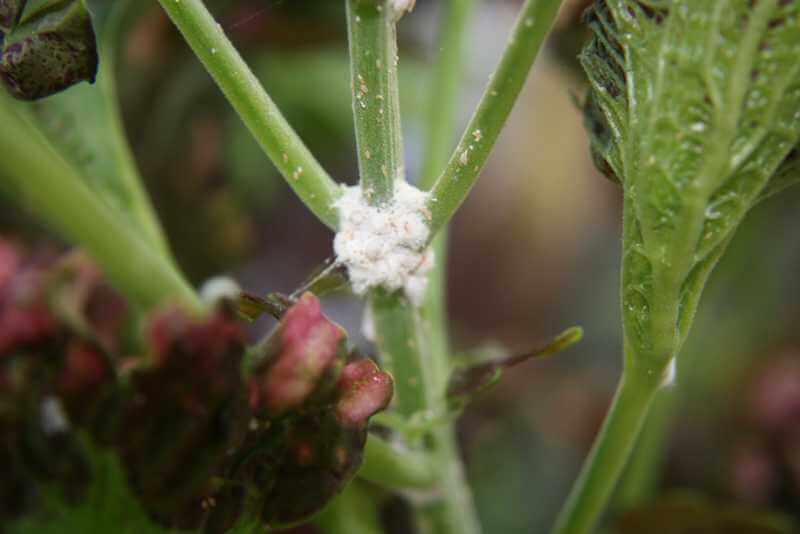I remember the first time I tried to care for a coleus plant. Let’s just say, it didn’t end well. My first attempt turned into a crispy, sunburnt mess.
But, over the years, I’ve learned the tricks of the trade, and now my coleus are the stars of my garden—bursting with color and life! So, if you're looking to master coleus care, you're in the right place.
About Coleus
Coleus plants, also known as "painted nettle," are one of the easiest plants to grow if you know what you're doing.
These beauties are known for their vibrant foliage, ranging from deep purples to neon greens. But don’t let their pretty leaves fool you; coleus can be a bit temperamental if you’re not careful.
I mean, one minute they’re flourishing, and the next, they’re throwing a fit because they got too much sun. Been there, done that!

- Fun Fact: Coleus plants were once used as ornamental plants in Victorian-era gardens, prized for their colorful and varied foliage.
Coleus Plant Profile
- Botanical Name: Plectranthus scutellarioides
- Family: Lamiaceae (Mint family)
- Plant Type: Perennial (grown as an annual in cooler climates)
- Sun Exposure: Partial shade to full shade
- Soil Type: Well-draining, loamy soil
- Soil pH: Slightly acidic to neutral (6.0 to 7.0)
- Bloom Time: Summer
- Flower Color: Small, purple or blue (often pinched off to focus on foliage)
- Hardiness Zones: 10–11 (USDA), grown as an annual in other zones
- Water Needs: Moderate to high, prefers moist but well-drained soil
- Height: 1 to 3 feet
- Spread: 1 to 2 feet
- Sowing: Best propagated by cuttings; seeds can also be sown in early spring
- Native Area: Southeast Asia, Malaysia
Read Next:
Why Coleus Plants Deserve a Spot in Your Home
Coleus plants aren’t just pretty faces—they offer a ton of benefits that make them a fantastic addition to any home. Whether you’re a seasoned plant parent or just getting started, coleus is the plant for you. Here's why:
- Vibrant Colors Year-Round: No matter the season, coleus plants keep their stunning, multicolored foliage. Whether it's bold greens, deep purples, or flashy pinks, they add a splash of color that brightens up any space—even in the dead of winter!
- Easy to Care For: Even if you don’t have a green thumb, coleus is one of those plants that forgive your mistakes. Forget to water for a day or two? No problem. The plant might droop a bit, but give it some love, and it’ll bounce back quickly.
- Indoor Air Purifiers: Like many other houseplants, coleus helps to improve indoor air quality. They absorb carbon dioxide and release oxygen, keeping your home fresher and healthier.
- Low Light Tolerance: While coleus love bright, indirect light, they’re also super tolerant of low-light conditions, making them perfect for those darker corners of your home that other plants might reject.
Coleus Care Tips

Here’s where the rubber meets the road. I’ll walk you through how to care for coleus step by step, and, trust me, once you get the hang of it, it’ll be second nature.
1. Light
Coleus plants are like Goldilocks when it comes to light. Too much sun, and they’ll scorch; too little, and they’ll sulk. I learned this the hard way when I planted mine in full sun—cue the crispy leaves. Ideally, they need bright, indirect light or partial shade.
If you’re growing them indoors, a north- or east-facing window is perfect. Outside, find a spot with dappled sunlight. You’re aiming for a sweet spot—just enough light to keep those vibrant colors popping without burning them to a crisp.
2. Water
Watering coleus is another tricky one. I used to overwater my plants, thinking I was doing them a favor. Spoiler alert: they hate sitting in soggy soil. They like moist, well-draining soil, so make sure to water when the top inch feels dry.
In the summer, you might need to water more frequently, especially if they're outdoors. But don't drown them, okay? Root rot is a real buzzkill.
3. Soil
Speaking of soil, coleus loves well-draining, fertile soil. I’ve found that a standard potting mix with some added perlite works wonders.
If you’re planting in the garden, make sure the soil is loose and airy, allowing the roots to breathe. And, hey, throw in some organic matter or compost while you're at it—they’ll thank you later with lush, vibrant growth.
4. Temperature & Humidity
Coleus plants are tropical by nature, so they thrive in warm temperatures (think 60-75°F). Anything below 50°F? Nope. They’ll start to sulk, and you might even see some leaf drop.
As for humidity, the higher, the better. If you're keeping them indoors, misting them occasionally or placing them near a humidifier will make them super happy. No one likes dry air—your coleus included.
5. Fertilizer
When it comes to fertilizing, less is more. I used to go overboard, but trust me, coleus plants aren’t heavy feeders. A balanced liquid fertilizer every two weeks during the growing season (spring through summer) is plenty. In winter? Skip it. They’re not growing much, so there’s no need to feed them.
6. Pruning
If you want bushy coleus plants (and who doesn’t?), regular pruning is key. Pinching back the stems encourages new growth, and it keeps the plant from getting leggy.
I learned that the hard way after my coleus shot up like a skyscraper but had no side branches. A little trim here and there will keep them looking full and fabulous. Plus, it’s kind of therapeutic, you know?
Indoor vs. Outdoor Coleus Care
Now, this is a biggie. Caring for coleus indoors and outdoors requires slightly different tactics. I’ve tried both, and each has its perks—and headaches.
Coleus Care Indoors
Indoors, coleus is like that high-maintenance friend. You need to watch the light, mist them, and make sure they aren’t too close to drafty windows. But they reward you with beautiful, colorful leaves year-round.
My indoor coleus loves being next to a bright window with indirect light, and every so often, I’ll rotate the pot to keep it growing evenly. Watering is less frequent indoors, but don’t let them dry out too much.
Coleus Care Outdoors
Outside, they’re a bit more chill, especially in partial shade. You just need to make sure they’re watered regularly during hot spells and protect them from the midday sun. Once, I left mine out during a heatwave without enough water, and it was not pretty. Lesson learned.
When to Plant Coleus
Knowing when to plant your coleus is essential to getting the most out of these colorful beauties. Timing is everything when it comes to coleus, especially if you’re growing them outdoors.
Indoor Planting:
If you’re starting your coleus indoors (whether from seeds or cuttings), late winter to early spring is the best time. This gives the plants time to grow strong before the outdoor growing season starts. Plus, you’ll get to enjoy their beauty as early as possible!
Outdoor Planting:
Coleus are warm-weather plants, so if you're planting them outside, wait until all risk of frost has passed. This is usually in late spring, depending on your local climate.
Coleus hate the cold, so planting too early will leave you with a sad, frost-damaged plant. Check your local frost dates to know when it's safe to plant them in your garden.
Planting from Seeds:
If you’re growing coleus from seed, start them indoors about 8-10 weeks before the last frost. Once the seedlings are sturdy enough (usually after they’ve grown a few inches tall), you can transplant them outside after the frost risk is gone.
Related:
Transplanting:
When moving coleus outdoors, wait for temperatures to stabilize. Coleus thrive in temps of 60°F (16°C) or above. Any lower, and they’ll struggle. So, if you’re transplanting, make sure the nights aren’t too cold.
Propagating Coleus: Step-by-Step Guide
Coleus propagation is one of the easiest and most rewarding parts of growing these plants. I’ve propagated so many coleus plants that I’ve practically run out of space! Here’s a simple, step-by-step guide to multiplying your coleus collection:
- Choose a Healthy Parent Plant: Look for a healthy, non-flowering coleus plant. Flowering can slow down the propagation process, so it’s better to pick a plant that’s all about the leaves.
- Take a Cutting: Using clean, sharp scissors or pruners, snip a 4-6 inch piece of stem from just below a leaf node. The leaf node is where the magic happens—it’s where the roots will grow from. Make sure the cutting has a few leaves attached at the top.
- Remove Lower Leaves: Gently strip off the leaves from the bottom 2 inches of the cutting. You want to leave the upper leaves intact but get rid of the lower ones to avoid rot when the stem is in water.
- Place in Water: Stick your cutting in a glass of water, making sure the leaf nodes (where the leaves were) are submerged. Place the glass in bright, indirect light. In about 1-2 weeks, you’ll start to see roots forming.
- Transplant to Soil: Once the roots are about 1-2 inches long, it’s time to transplant your cutting into a small pot with well-draining soil. Keep the soil moist, but not soggy, and your new coleus plant will start growing in no time!
- Monitor Growth: Over the next few weeks, keep an eye on the cutting to make sure it's taking root in the soil. Water regularly, but don’t overdo it. Soon enough, you’ll have a thriving new coleus plant!
Planting Coleus in Pots
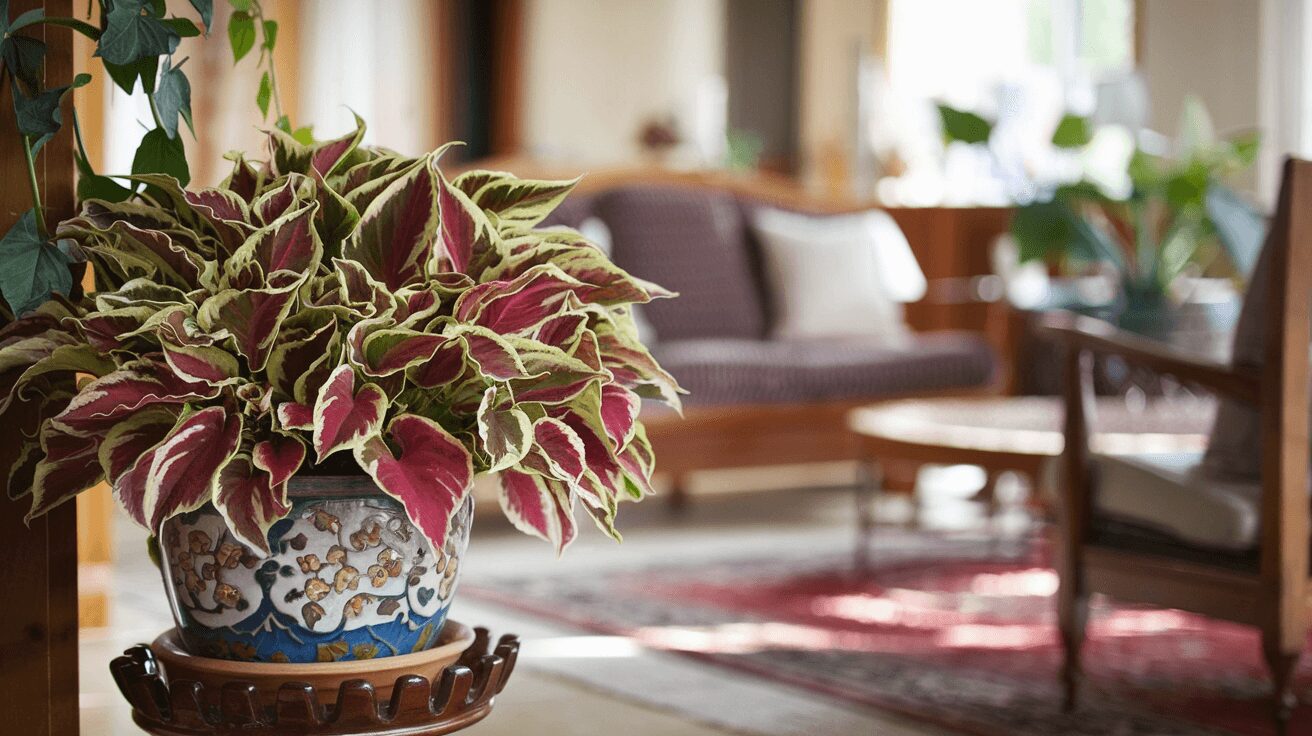
Planting coleus in pots is one of the best ways to grow these colorful beauties. Whether indoors or on your patio, they shine in containers. Here’s how to get the best results when planting coleus in pots:
1. Choose the Right Pot
First things first—coleus needs space. Pick a pot that’s at least 8-10 inches wide and has good drainage. A pot with drainage holes is a must! Trust me, soggy roots equal sad plants. And if you’re like me and tend to overwater sometimes, the drainage holes are your best friend.
2. Prepare the Soil
Use a high-quality, well-draining potting mix. I like to mix in some perlite for extra drainage. You can also toss in a bit of compost or organic matter to give your coleus a nutrient boost. They love rich soil!
3. Planting the Coleus
Place your coleus in the pot, making sure it’s centered. Gently fill in the gaps with soil, pressing down lightly to remove any air pockets. Don’t bury the plant too deep—just enough to cover the roots.
4. Water Thoroughly
After planting, water your coleus thoroughly until water flows out of the drainage holes. This helps the roots settle into their new home. Keep the soil moist, but not waterlogged, as coleus hate sitting in soggy soil.
5. Pruning for Bushiness
To encourage bushy growth, pinch back the tips of the stems every few weeks. This might seem counterintuitive, but trust me, it works! Pinching stimulates new branches and helps the plant grow fuller.
6. Repotting
As your coleus grows, it may outgrow its pot. A good rule of thumb is to repot every year, or whenever you notice the roots starting to crowd the pot.
Gently remove the plant from its old pot, loosen the roots, and place it in a larger container with fresh soil.
Read Next:
Common Coleus Problems (And How to Fix Them)
Even though coleus are relatively easy to care for, they can still run into a few hiccups. Here are some common problems you might face and how to tackle them:
1. Leggy Growth
Leggy growth is when your coleus starts to grow tall and spindly with fewer leaves. This usually happens when the plant isn’t getting enough light. To fix it, move your coleus to a brighter spot or pinch back the stems regularly to encourage bushier growth.
2. Fading Colors
One of the reasons we love coleus is for their vibrant colors. But if your coleus starts looking a bit dull, it might be getting too much direct sunlight.
Too much sun can bleach the colors right out of the leaves. Solution? Move it to a spot with bright, indirect light. Also, check your fertilizer. A nutrient imbalance can sometimes cause the colors to fade too.
3. Yellowing Leaves
Yellow leaves are a sign of overwatering. I’ve been guilty of this, and trust me, coleus do not appreciate having soggy feet. Let the soil dry out a bit before watering again, and make sure the pot has proper drainage.
4. Pests (Aphids, Spider Mites)
Coleus can sometimes attract pests like aphids or spider mites, especially if the plant is stressed. You’ll notice little specks on the leaves or a fine webbing from spider mites. A simple solution is to spray the plant with a mixture of water and mild soap, or use neem oil to keep those pests at bay.
5. Root Rot
Root rot happens when your plant is sitting in waterlogged soil for too long. If your coleus looks wilted despite regular watering, and the soil feels soggy, you might be dealing with root rot.
To fix root rot, you’ll need to act fast. Gently remove the plant from its pot and inspect the roots. If they’re mushy and brown, trim away the affected roots with clean scissors.
Repot your coleus in fresh, well-draining soil, and reduce your watering to allow the plant to recover. Root rot is no joke, but if caught early, your coleus can bounce back.
6. Leaf Drop
If your coleus starts dropping leaves, don’t panic. It could be due to a sudden change in temperature or stress from being moved.
Coleus hate drafts, so avoid placing them near air conditioners, heaters, or cold windows. Consistent care and finding a stable environment should stop the leaf drop and help the plant regain its lush appearance.
7. Burnt Leaf Edges
When the edges of your coleus leaves turn brown and crispy, it's often a sign of too much direct sunlight or not enough water. If your plant is outside, try moving it to a shadier spot. Indoors, make sure it’s not too close to a south-facing window where the sun is strongest.
Water regularly to keep the soil consistently moist, but not soaked.
8. Stunted Growth
If your coleus isn’t growing as quickly as it should, the problem might be poor soil, lack of nutrients, or being pot-bound.
Make sure your coleus is planted in rich, well-draining soil, and consider fertilizing once a month with a balanced liquid fertilizer. If the plant has been in the same pot for more than a year, check the roots to see if they’re cramped, and repot if necessary.
Final Thought
Coleus plants are a fantastic addition to any home or garden, bringing vibrant colors and personality to your space. From the ease of propagation to the joy of watching their lush foliage grow, they’re perfect for both beginners and experienced plant lovers alike.
Whether you’re planting them in pots, dealing with common problems, or simply looking to brighten up a dull corner of your home, these plants will reward you with beauty and simplicity.
Got any coleus stories or tips of your own? Drop them in the comments below—I’d love to hear how you're growing and caring for your coleus plants!
External Resources: For more gardening tips on coleus care, check out The Spruce and Gardener's World.
FAQ
Does coleus like sun or shade?
Coleus plants prefer partial shade, especially outdoors. Too much direct sunlight can cause the leaves to burn, while deep shade might dull their vibrant colors. For the best results, aim for bright, indirect light or morning sun with afternoon shade.
Is coleus an indoor or outdoor plant?
Coleus can thrive both indoors and outdoors, making it a versatile plant. Indoors, it enjoys bright, indirect light, while outdoors it prefers a shaded or partially shaded spot. Just make sure to protect it from harsh sunlight and cold drafts.
How do you care for a potted coleus plant?
To care for a potted coleus, use well-draining soil, water it regularly to keep the soil moist but not soggy, and place it in a location with bright, indirect light. Pinch back the stems to encourage bushy growth, and fertilize every month during the growing season for best results.
How do I keep my coleus happy?
To keep your coleus happy, provide it with consistent moisture, bright but indirect light, and regular pruning to promote fuller growth. Make sure the soil is well-draining, and avoid extreme temperatures or drafts. Fertilize monthly to keep the plant lush and vibrant.

